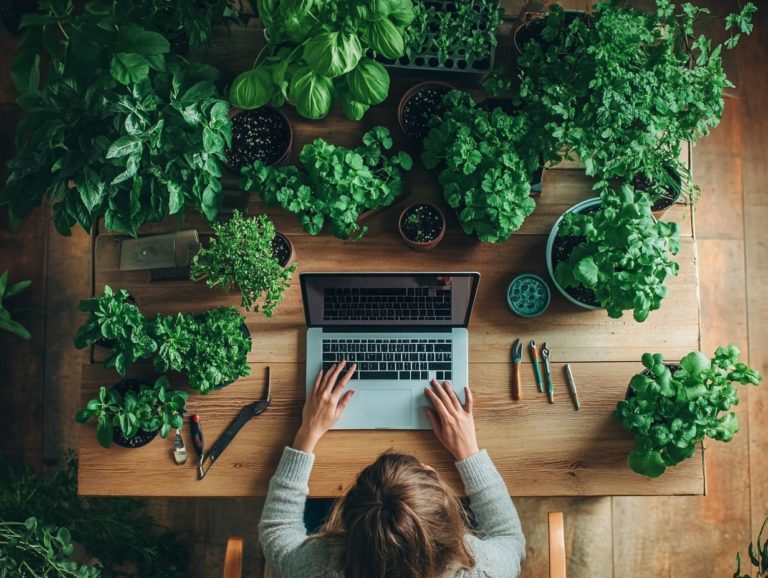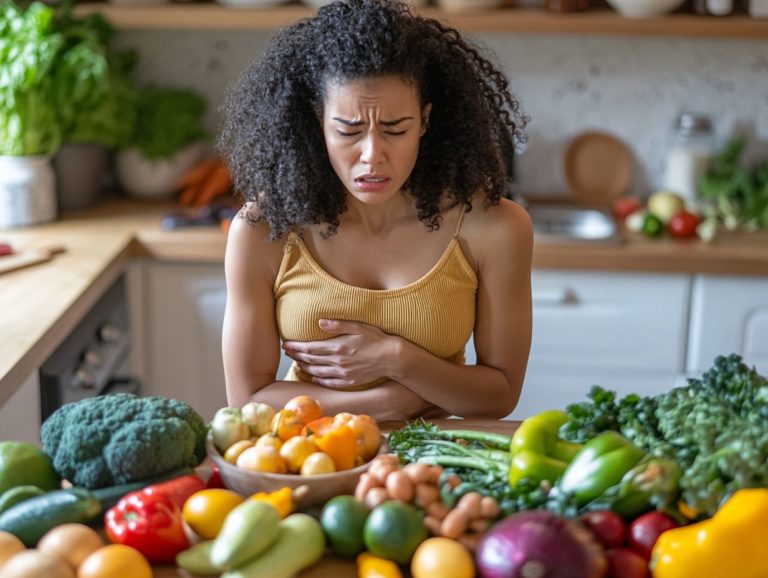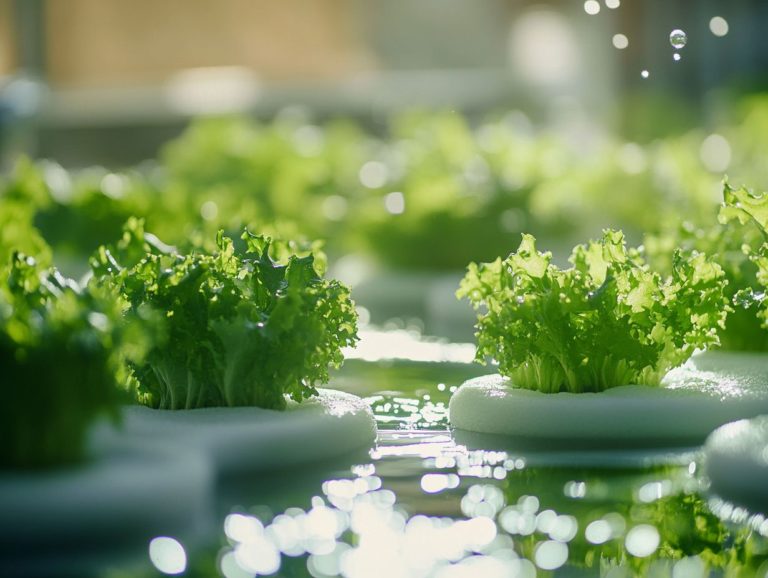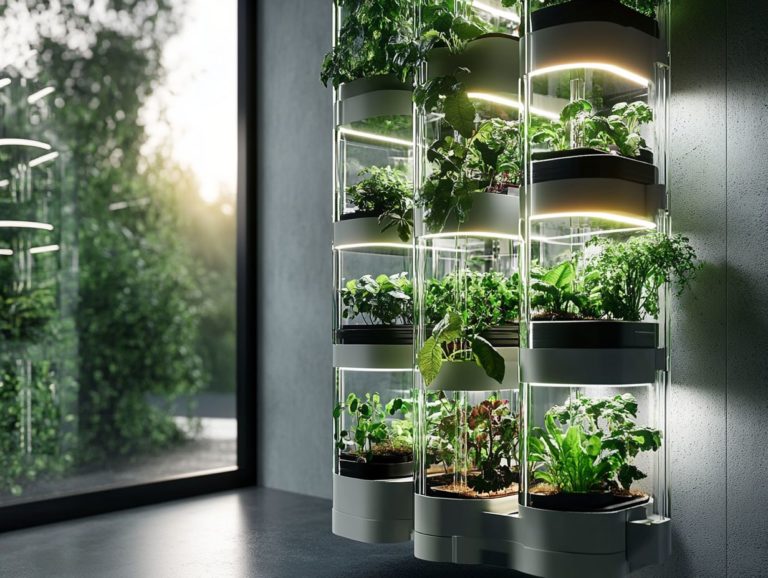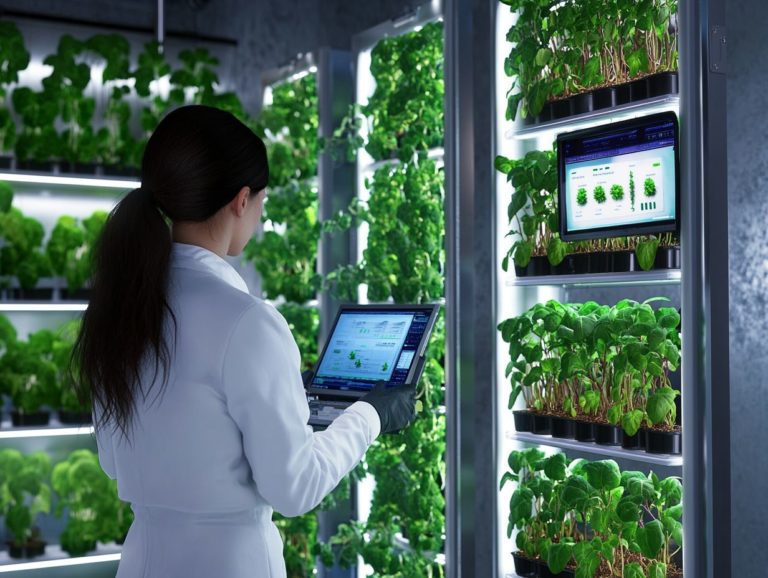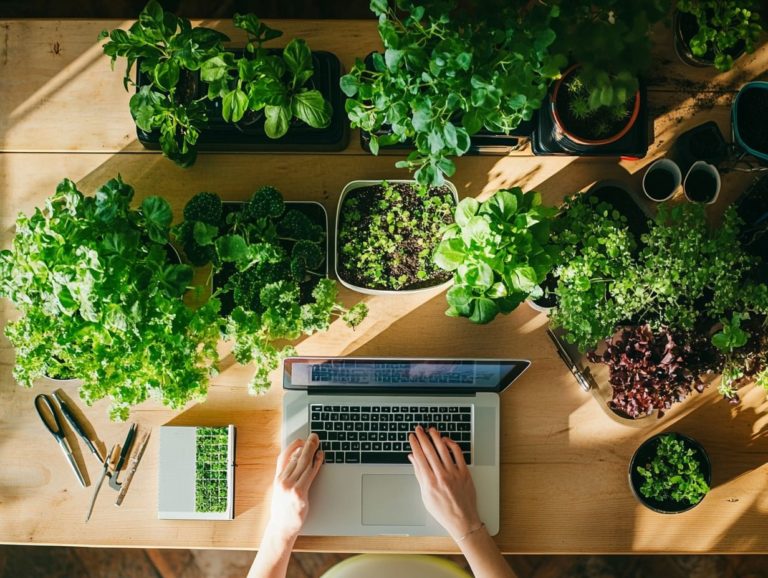What is Hydroponic Gardening in a Greenhouse?
Hydroponic gardening is revolutionizing the way you grow plants, especially in the controlled environments of greenhouses. This innovative method removes the need for soil, allowing roots to thrive in nutrient-rich water instead.
Discover the advantages of hydroponics growing, explore the various hydroponic systems you can implement, and follow a comprehensive step-by-step guide to setting up your own hydroponic garden.
You ll also find valuable tips on selecting the best plants and troubleshooting common issues.
Get ready to transform your greenhouse into a vibrant, soil-less paradise! This is a key aspect of the agricultural revolution.
Contents
- Key Benefits:
- Benefits of Hydroponic Gardening in a Greenhouse
- Types of Hydroponic Systems
- How to Set Up a Hydroponic Garden in a Greenhouse
- Choosing the Right Plants for Hydroponic Gardening
- Troubleshooting Common Issues in Hydroponic Gardening
- Frequently Asked Questions
- What is Hydroponic Gardening in a Greenhouse?
- How does Hydroponic Gardening in a Greenhouse work?
- What are the advantages of Hydroponic Gardening in a Greenhouse?
- What types of plants can be grown using Hydroponic Gardening in a Greenhouse?
- What equipment is needed for Hydroponic Gardening in a Greenhouse?
- Is Hydroponic Gardening in a Greenhouse sustainable and environmentally friendly?
Key Benefits:
- Hydroponic gardening is a method of growing plants without soil, using water and nutrients instead.
- Growing hydroponically in a greenhouse offers many benefits, including climate control, reduced water usage, and year-round production.
- There are various types of hydroponic systems to choose from, each with its own advantages and challenges when setting up in a greenhouse.
What is Hydroponic Gardening?
Hydroponic gardening is an innovative agricultural practice that allows you to cultivate plants in nutrient-rich water solutions, completely bypassing the need for soil. This method not only maximizes your plant growth but also dramatically reduces water usage, positioning it as a crucial element of the sustainable food movement.
By employing various hydroponic systems, such as nutrient film technique (NFT) where a thin film of nutrient solution flows over the plant roots and deep water culture, you can create controlled environments that enhance crop yields and improve resource efficiency.
Hydroponics has a rich history, dating back to ancient civilizations like the Hanging Gardens of Babylon. Today, with advancements in hydroponic greenhouse technology, this method provides numerous advantages over traditional gardening, including a smaller land footprint and accelerated growth cycles. To learn more about the technique, check out what is passive hydroponic gardening?
The meticulously balanced nutrient solutions deliver essential minerals to your plants, promoting healthier and more productive harvests. Plus, hydroponic systems significantly reduce the risk of pests and diseases often associated with soil, making this an attractive option for hydroponic farmers committed to sustainability and environmental stewardship.
Benefits of Hydroponic Gardening in a Greenhouse
Hydroponic gardening in a greenhouse setting offers a wealth of benefits, truly marking it as a hallmark of the agricultural revolution. Imagine enjoying fresh produce all year long this is the power of hydroponic gardening!
This innovative method fosters enhanced plant growth while significantly reducing water consumption thanks to its closed-loop systems.
By harnessing climate control technologies, you can optimize growing conditions for a diverse array of crops, resulting in increased yields and improved resource efficiency. Hydroponic greenhouses also support sustainability by minimizing the reliance on chemical fertilizers and pesticides, ultimately contributing to cleaner food production.
Ready to dive in? Start your hydroponic garden today and experience the future of farming!
Advantages for Greenhouse Growing
Growing in a greenhouse with hydroponic systems which means growing plants without soil, using a nutrient-rich water solution offers numerous advantages for both novice and seasoned hydroponic farmers. One of the standout benefits is the impressive crop yields you can achieve through optimized growing conditions. These controlled environments shield your plants from harsh weather and pesky pests, creating a fertile ground for success.
Imagine growing fresh produce all year round! With the ability to cultivate indoors, you ensure your urban community has access to fresh produce, no matter what s happening outside.
The potential for automation in hydroponic systems simplifies your operations, making it effortless to manage nutrient solutions and monitor plant growth effectively. In urban landscapes, scalability becomes a significant advantage, enabling you to expand your operations without the limitations often found in traditional farming.
Energy efficiency is another important part, as many hydroponic systems employ LED lighting and recycle water, which minimizes waste and keeps your energy bills in check. The capacity to produce high-quality crops, like tomatoes and leafy greens, elevates the appeal of greenhouse hydroponics, positioning it as not only a sustainable option but also an economically viable one. If you’re curious about the methods behind this innovative practice, check out what is hydroponic gardening?
As cities grow more populated, these systems become essential in boosting local food production, enhancing food security, and supporting local economies while fostering a stronger urban community.
Types of Hydroponic Systems
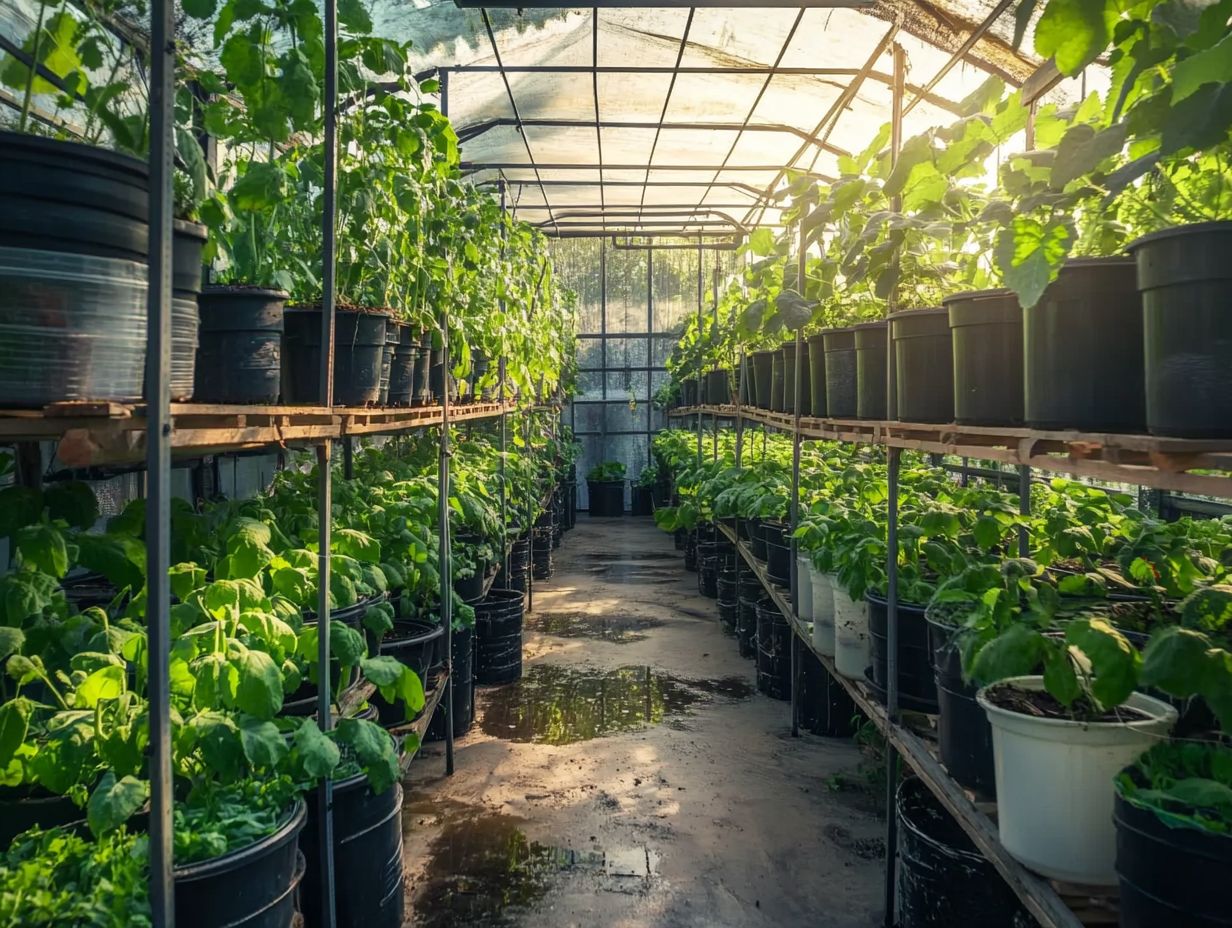
You ll discover a variety of hydroponic systems, each meticulously crafted to meet specific growing needs and accommodate different plant varieties, including tomatoes, cucumbers, and lettuce, making them essential in modern agriculture.
Among the most popular are the nutrient film technique (NFT), which expertly delivers nutrient solutions directly to the roots; deep water culture, where plants thrive suspended in nutrient-rich water; and the ebb and flow system, which adeptly floods and drains the planting area at intervals.
Vertical farming is a powerful way to optimize space and enhance production efficiency, further expanding the array of hydroponic systems available for both commercial enterprises and home gardeners, highlighting the automation potential.
Overview of Different Setups
Understanding the various setups in hydroponics is essential for selecting the right system that aligns with your gardening goals, as each option offers unique advantages in how well the system works and crop yields.
For example, in systems like deep water culture, plants thrive directly in a nutrient solution, often resulting in rapid growth and impressive yields. Alternatively, setups that utilize diverse growing mediums, such as rock wool or clay pellets, provide essential support for plant roots while effectively retaining moisture and nutrients.
Exploring configurations like nutrient film technique and aeroponics can unveil different avenues to enhance growth. Nutrient film technique allows a thin film of nutrient-rich water to flow past the roots, while aeroponics suspends plants in air, misting the roots to maximize oxygen exposure. The choice of growing mediums is pivotal; it not only impacts root stability but also influences nutrient absorption.
Incorporating automation into your hydroponic systems, such as timers for nutrient delivery and pumps, can greatly enhance efficiency, reduce labor, and ensure optimal conditions for plant health. This strategic approach enables you to achieve your desired results with minimal effort.
How to Set Up a Hydroponic Garden in a Greenhouse
Setting up a hydroponic garden in a greenhouse demands thoughtful planning and execution. With a well-crafted step-by-step guide, you can grow a flourishing environment for your plants.
Start by selecting the ideal hydroponic greenhouse structure tailored to your climate control needs, ensuring it can effectively regulate temperature, humidity, and light levels.
Next, choose the right hydroponic system based on the crops you wish to grow be it nutrient film technique or deep water culture. Prepare a nutrient solution that supplies essential elements for optimal plant growth.
Finally, adopt efficient water usage practices to enhance resource efficiency and support the health of your plants throughout their growth cycle. Don t miss out on the chance to start your greenhouse hydroponic garden today!
Step-by-Step Guide
This step-by-step guide presents the essential processes for creating a successful hydroponic garden. It starts with selecting the right hydroponic systems and effectively managing your nutrient solution.
First, choose a hydroponic setup that aligns with the specific plants you plan to grow. Think tomatoes, cucumbers, or lettuce, which thrive in various systems.
Next, prepare a nutrient solution tailored to your chosen plants, ensuring you create optimal growing conditions for vibrant growth.
Once your system is up and running, maintaining ideal temperatures, humidity levels, and pH balance is crucial. These factors significantly influence plant health and yield, so regular monitoring helps you spot potential issues early.
Establish a feeding schedule based on your crops’ growth cycles. Be ready to make adjustments mid-cycle to accommodate your plants’ evolving nutrient needs. By consistently observing their growth, you can implement timely interventions.
With the right care and attention, your hydroponic garden can be a spectacular success! Achieve high crop yields, making hydroponics not just a project but a truly rewarding endeavor in the field of Agriculture.
Choosing the Right Plants for Hydroponic Gardening
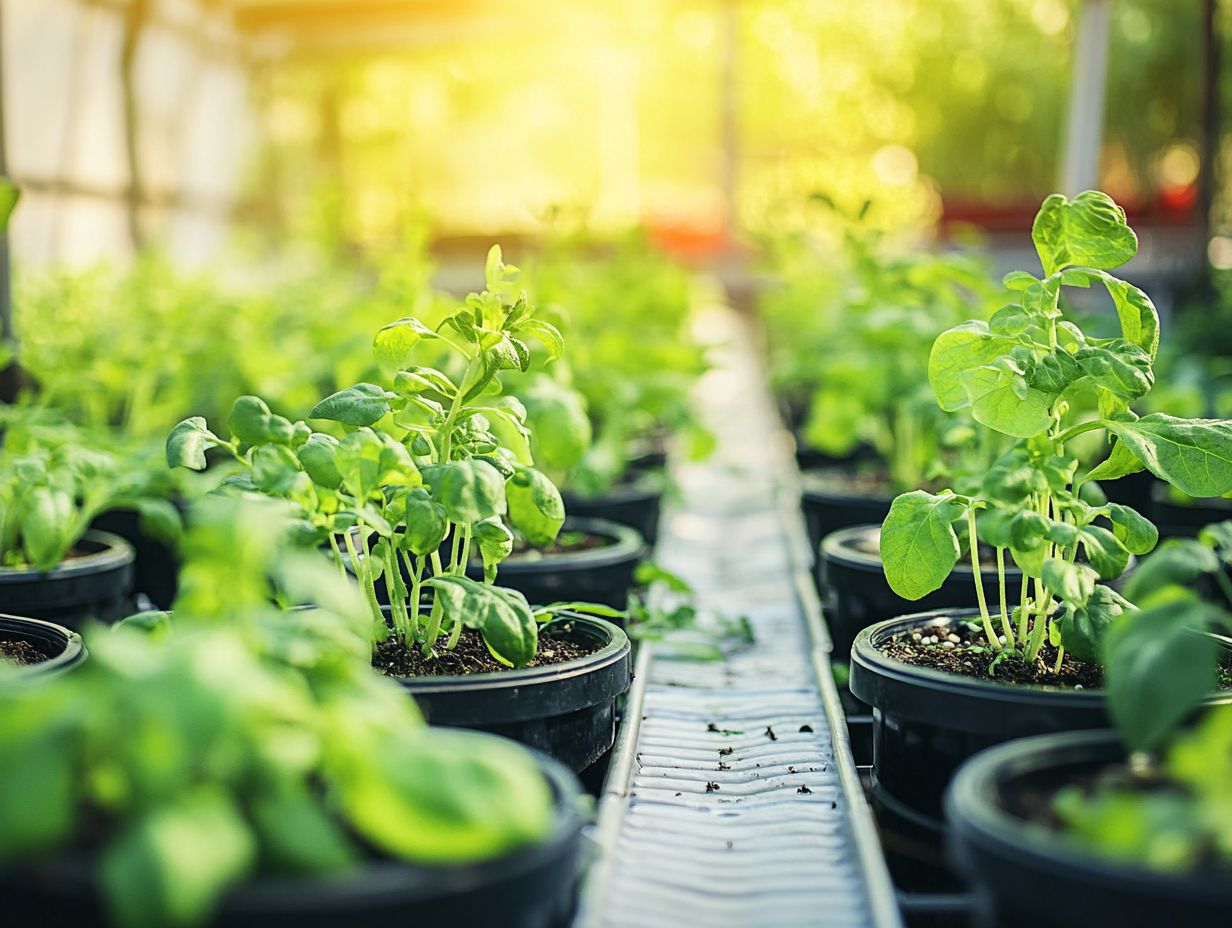
Selecting the right plants for hydroponic gardening is essential for ensuring thriving growth and maximizing crop yields. This applies whether you’re operating on a commercial scale or tending to your home setup.
Consider fast-growing varieties like lettuce, basil, and various herbs. These plants flourish in controlled environments and contribute significantly to the sustainable food movement.
In urban settings, crops like tomatoes and cucumbers often work well. They’re nutritious and adapt effectively to vertical farming techniques, optimizing both space and resources.
Best Plants for Greenhouse Hydroponics
The best plants for greenhouse hydroponics excel in nutrient solutions and adapt to controlled growing conditions, leading to impressive crop yields. Leafy greens, such as lettuce and spinach, are perfect candidates due to their rapid growth and minimal space requirements.
Herbs like basil and mint thrive in hydroponic systems, offering culinary versatility and sustainability by reducing reliance on traditional farming methods.
You can successfully cultivate fruiting plants, like strawberries and tomatoes, in hydroponic environments. They benefit from consistent nutrient supply and optimized light exposure. Understanding the specific growth habits of each plant is essential; for example, leafy greens prefer cooler temperatures, while fruiting varieties generally flourish in warmer conditions. If you’re interested in innovative gardening methods, consider exploring what vertical hydroponic gardening is.
Their nutrient requirements will vary, so create tailored feeding schedules to ensure healthy growth. Best practices include regular pH testing and maintaining adequate oxygen levels in the nutrient solution, which are crucial for robust plant health and maximizing yields.
By mastering these elements, you can significantly contribute to sustainable food production, even in limited spaces.
Troubleshooting Common Issues in Hydroponic Gardening
Troubleshooting common issues in hydroponic gardening is crucial for ensuring your plants thrive and your crop yields reach their full potential. Many hydroponic gardeners face challenges like nutrient deficiencies, pH imbalances, and pests, all of which can stifle plant growth and diminish overall production.
By recognizing the signs of these problems and applying effective solutions, you can cultivate a flourishing hydroponic environment that champions sustainable food practices.
Dive into hydroponic gardening now and enjoy fresh, home-grown produce!
Identifying and Addressing Problems
Identifying and addressing problems in hydroponic gardening requires keen observation and a clear understanding of plant needs. This is particularly important for nutrient solutions and growing conditions.
You might notice common signs of nutrient deficiencies, such as yellowing leaves and stunted growth. These issues can often be resolved by fine-tuning the nutrient solution s composition.
Keep a close eye on pH levels and environmental factors. Light and humidity are crucial for optimizing resources and promoting strong plant growth.
A systematic approach to diagnosing issues can elevate your gardening outcomes. For instance, when your plants show signs of distress, promptly analyze the nutrient solution.
Pay attention to both macro and micronutrient ratios, which refer to large and small nutrient amounts. By adjusting the concentration of nutrients according to specific growth stages, you can ensure optimal absorption and flourishing plants.
Consistent environmental controls like regulating temperature and managing airflow are vital. They help prevent stressors that can harm plant health.
Act quickly! Tackling issues right away breathes life back into your plants and boosts productivity. Timely interventions enhance overall yield and illustrate the importance of proactive gardening practices.
Frequently Asked Questions
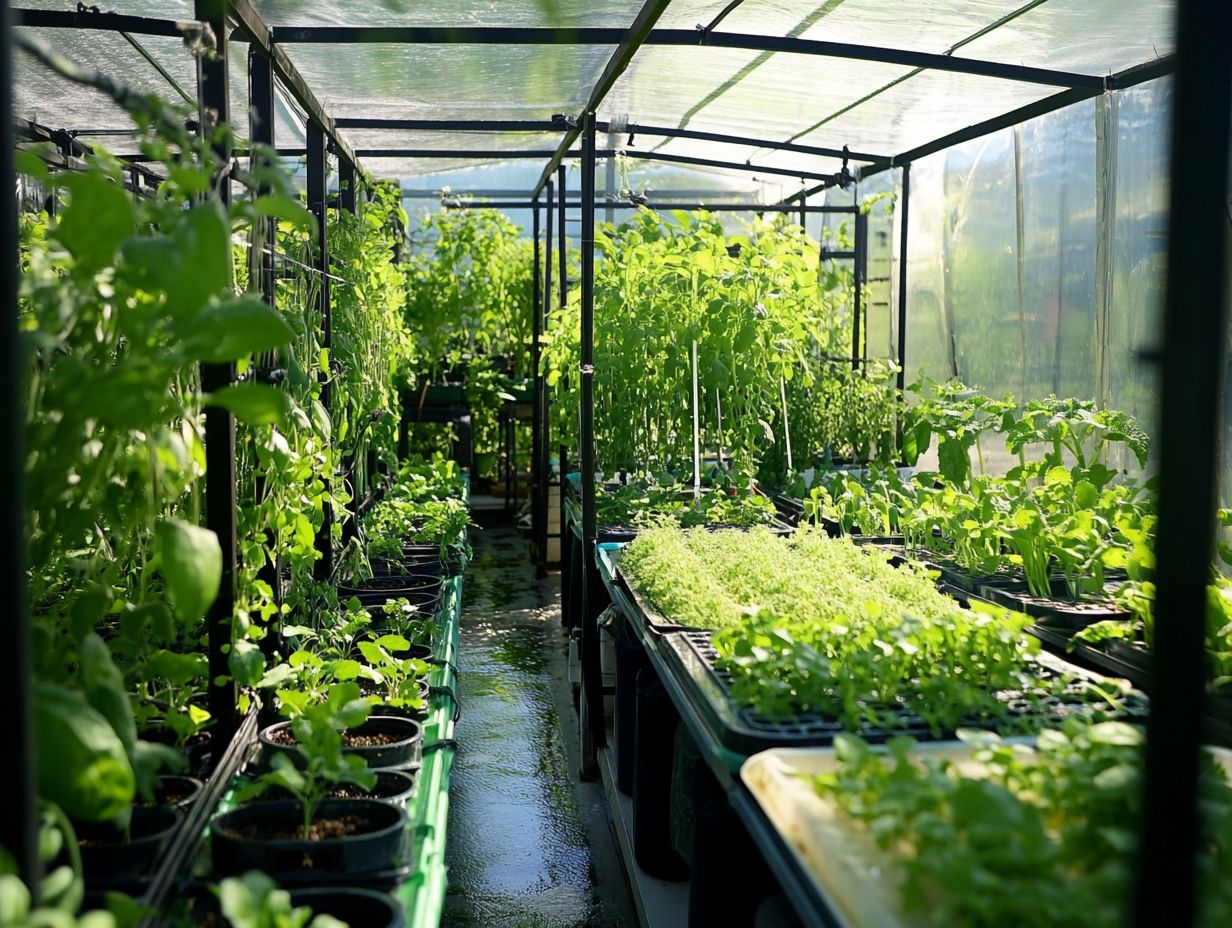
What is Hydroponic Gardening in a Greenhouse?
Hydroponic gardening in a greenhouse is a method of growing plants using a soilless system. It involves a controlled environment of a greenhouse.
How does Hydroponic Gardening in a Greenhouse work?
In this system, plants grow using water and mineral nutrient solutions instead of soil. The greenhouse provides optimal conditions of temperature, light, and humidity.
What are the advantages of Hydroponic Gardening in a Greenhouse?
Hydroponic gardening in a greenhouse allows for year-round plant growth and higher yields. It also offers faster growth compared to traditional soil-based gardening.
This method minimizes the risk of pests and diseases and reduces the need for pesticides.
What types of plants can be grown using Hydroponic Gardening in a Greenhouse?
Almost any plant can be grown using this method, including vegetables, herbs, fruits, and even flowers. It is especially popular for high-demand crops like tomatoes, lettuce, and strawberries.
What equipment is needed for Hydroponic Gardening in a Greenhouse?
The equipment needed includes a greenhouse structure and a hydroponic system. Additionally, you will need lighting, temperature and humidity control systems, and nutrient solutions.
These setups can range from simple DIY arrangements to more advanced commercial systems.
Is Hydroponic Gardening in a Greenhouse sustainable and environmentally friendly?
Yes, it is considered sustainable and environmentally friendly. This method uses less water and space compared to traditional soil-based gardening.
It also eliminates the need for chemical fertilizers and reduces the carbon footprint of food production.
Ready to start your hydroponic garden? Subscribe for more tips and tricks!

